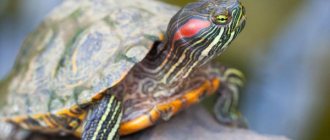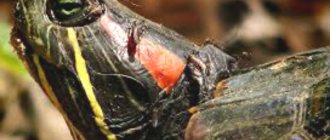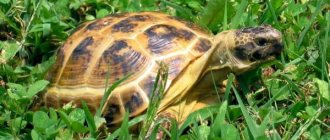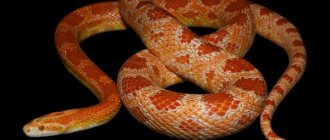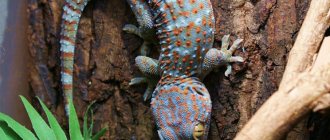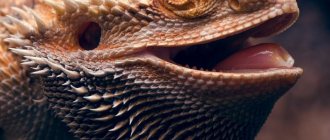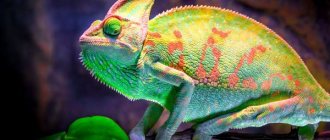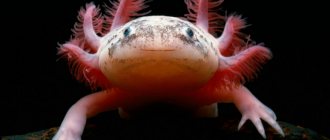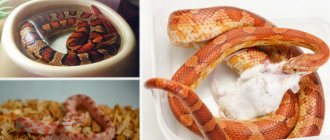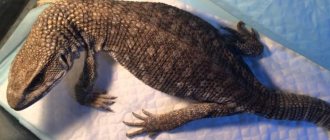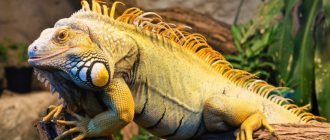Nowadays, it has become very fashionable to keep unusual animals at home, such as turtles. Turtles are divided into land and aquatic. This article will talk about how to care for a land turtle .
Turtles attract attention because they lead a calm and measured lifestyle, without creating unnecessary noise and not requiring special attention. They are not carriers of various diseases, and care comes down to providing her with conditions for a normal life. Therefore, caring for such a turtle will not be difficult if there are children in the family. As a rule, caring for a pet turtle is a priority for children, not adults, especially since children pick up on everything very quickly and can do it much better than adults. The main thing is to explain everything to them in time; as a rule, once is enough.
Turtle selection
Basically, they buy Central Asian (steppe) turtles, which are not very demanding in terms of care. They can grow up to 20cm in length and are characterized by the presence of a small, rounded shell of a yellow-brown hue in combination with brown spots.
To begin with, it shows its activity in the morning and evening hours, and during the day and at night it rests in some kind of shelter. Based on this, we can conclude that for such a turtle it is necessary to create similar conditions.
The Central Asian tortoise goes into a state of anabiosis (hibernation) twice a year, thereby escaping heat, cold and lack of food. This does not mean that she will do this at home, because she has enough food and the temperature is within optimal limits.
Large matamata predator
To understand what pet turtles are like, it’s worth meeting a representative of the Matamata breed. It reaches 45 cm in length and has a rather bright and unusual appearance. The upper part of the shell has a pyramidal shape, the head is flat and triangular, at its end there is a flexible nasal process. On average, a reptile lives 50-60 years.
The matamata turtle has a unique appearance. Matamata is an omnivore; it prefers food of animal origin. He loves mollies, goldfish, earthworms, and guppies. Does not disdain even small mice and birds. It is best to feed it by introducing several fish into the aquarium: this way the turtle will have a choice, and it will not lose its hunting skills.
Since the turtle grows quite large, the aquarium should not interfere with its development as it should. Matamata is not as active as the European marsh turtle, but it is better to choose larger containers for it. Main characteristics of an aquarium for a matamata turtle:
- The aquarium should be deep - 200-250 liters.
- The acidity of the water is 5.0-5.5, you can add a little peat or tree leaves.
- Water temperature - from +28 °C to +30 °C. It should be stable throughout the year; you should not lower it in the fall or winter.
- The soil of the aquarium should be sandy so that the turtle has the opportunity to bury its head in it. In addition, plants and algae that the matamata is accustomed to in its natural environment can be planted in the sand. It is better to add driftwood, since due to its inactivity the turtle likes to lie on the bottom for a long time.
- Despite the fact that the turtle almost never comes out to bask on land, a lamp above the aquarium is still necessary.
Matamata does not like to be disturbed. She regards any contact with a person as a stressful situation. The turtle should be handled only to wash it or move it to another aquarium. It is not suitable for families with children who have pets to play with - the matamata does not tolerate such interaction.
Keeping a turtle in a terrarium
Very often, turtle owners make the same grave mistake: they keep it on the floor. This is strictly prohibited, as the following consequences may occur:
- The turtle can catch a cold, as it needs heating from time to time.
- Might get an infection.
- May get injured.
Its habitat is a terrarium, no matter what they said.
Basic information
The living types of these reptiles are divided into two groups: marine (intended to live in large pools filled with sea water) and terrestrial. The latter species has many varieties, differing from each other in size and methods of care and maintenance.
Domestic turtles are most often land animals. They use water only for bathing and drinking. You can have almost any reptile as a pet, but future owners should remember: the larger the pet, the larger the terrarium it will need.
About 40 species of turtles are protected by law, as a result of which the concept of illegal import, export and sale has emerged. Basically, illegal immigrants place reptiles in unbearable living conditions, which is why some do not make it to the pet store, while others die after purchase or even transportation. Therefore, be more careful when choosing the place where you are going to buy your future pet. To ensure a legal sale, ask the seller to show the appropriate documents. This will ensure that you are purchasing a healthy animal.
Dimensions and arrangement of the terrarium
Taking into account the fact that a turtle can grow up to 20cm in length, the dimensions of the terrarium range from 100x50x30cm and no less. It should be spacious enough for the turtle to actively move around. It is not as slow as some people think, and it is impossible to have artificial barriers in the form of sticks or branches in the terrarium - these are all unnecessary.
The bottom of the terrarium is covered with a layer of sand and clay, but you cannot take sand from the yard or a nearby construction site, as it can introduce some kind of “infection.” The simplest, most affordable and reliable option is sawdust purchased at a pet store. They are changed as they become dirty, and the sand should be changed 1-2 times a month.
REPRODUCTION
Puberty occurs at the age of 6 years. Make sure turtles are completely healthy before breeding. Main conditions: hibernation, dense nutrition and warmth.
At home, you can distinguish turtles by the following characteristics: first, females are larger than males in size, second, if you turn the male over, you can see a small concavity on the shell, which is necessary for mating, third, the female’s tail is much thicker and larger, fourth, the female’s cloaca located at the very base of the tail.
Select several females so that they are larger in size than the males. Boys are placed in the enclosure with girls, and not vice versa. It is better if there are more females, let the males fight for the females, but only under your control, so as not to injure each other.
Video: how to care for a pet?
strong>A pregnant turtle is easy to spot: it becomes restless, hardly eats, and begins to fence off its territory. Offer her a choice of foods, but be sure to add calcium. Pregnancy lasts 2 months, but the turtle can tolerate it if it has not completely equipped a place for the eggs.
The baby turtles, about 3 cm in size, can sit in the shell for another 3 days after pecking. Only after this period, if they do not have enough strength to get out, can you intervene. Be careful if twin turtles appear, they are much weaker than single ones. Tie it around the umbilical cord, which is connected with thread. Then they separate themselves.
Babies should be kept separately! Living conditions are suitable for adults, only the food should be softer, irradiation should be carried out with a 10% UVB lamp. Under good conditions, your pet will live with you for 40 years.
Temperature and lighting
The temperature regime in the terrarium is maintained by a 75W incandescent lamp installed at a height of 20-30cm from the bottom of the terrarium. During the daytime, the temperature in the terrarium should be: in the shade +28-30°C, and in the area of the lamp +36-38°C. The terrarium is illuminated with a fluorescent lamp.
The terrarium must have a place for shelter. The shelter is located in the shade, and it can be made from any material, even thick cardboard.
The turtle needs water treatments approximately once a week. To do this, you need to take a vessel slightly larger than a turtle and pour water into it at a temperature of about +25°C and organize a bath. The water should be clean, and its level should reach the turtle’s neck.
Appearance
Animal body:
- head and eyes;
- neck;
- beak and tongue;
- shell;
- color;
- limbs;
- tail;
- dimensions.
The head of these reptiles is streamlined and designed in such a way that the animal can quickly pull it under its shell. In some species, the length of the neck is equal to the length of the shell.
These animals have a strong and hard beak with bulges inside, with sharp or jagged edges that act as teeth. The function of the shell is protection. The dorsal (upper) part is called the carapace, the ventral (lower) part is called the plastron.
They grow slowly throughout life. In adult individuals, the length of the shell is 20–30 cm. The tail is hidden inside the shell. The tip of the tail in some species is pointed, similar to a spike. Differences between Central Asian and red-eared cats in appearance
| Appearance | Central Asian | red-eared |
| Color | Yellow-beige color, shapeless dark spots on the shell. | The carapace has characteristic stripes of olive, black, and yellow colors. |
| Plastron | Dark color. | Smooth, variegated color: dark spots on a yellow background. |
| Head | The upper jaw is hooked. | From the eyes to the neck, on both sides there are yellow-red lines resembling ears. |
| Eyes | Located on the sides of the head in such a way that they look down; small, black. | Directed forward and upward, located near the crown. |
| Limbs | The front paws are flat, designed to dig soil, and the hind paws are powerful and strong. They have four toes on their front paws with blunt claws. | The feet have leathery membranes for swimming. |
| Dimensions | Cubs are born 3–3.4 cm long and weigh 10–12 grams. By the second year of life, the size will increase to 5 cm, by the fourth to 9 cm. The weight of an adult turtle grows to 2 kg. | A newborn cub is 2.4 cm long, and during the first year of life it gains 2.5–4.5 cm. At two years, its size will be 8 cm, at six years - 18 cm. |
Sense organs
Turtles have good low-frequency hearing and excellent color vision. Red-eared turtles have an excellent sense of smell and smell. They see both in water and above water. Hearing is like that of cats: they can distinguish dull sounds and vibrations. Nerve endings pass through the shell. Animals with a sense of touch distinguish the taste of food. Aquatic turtles are not adapted to breathe underwater; they swim up for oxygen.
When determining age, they are guided by size and also count the number of rings on the shell. In one year, 2–3 rings are formed. But this growth is not uniform; it is influenced by conditions of detention, illness, and hibernation. In older individuals, the carapace is smooth, the growth rings are pale. The younger the turtle, the brighter its color. Inappropriate maintenance and disease are the main causes of death.
Horsfield's tortoise is quite modest in size. The dimensions of its shell range from 13 to 25 centimeters in length. Males are inferior in size to females: their shell grows from 13 to 20 cm, and that of females from 15 to 25 cm. But at home, these animals grow up to 17-18 cm in length.
Their shell consists of 16 keratinized scutes on top and 13-15 similar scutes on the bottom. Another 25 scutes are located on the lateral surfaces of the shell. It has a round shape, slightly flattened at the top. On top, its color varies from olive-yellow-green to olive-brown. Dark spots are located on top of the main color; their color correlates with the color of the soil on which the turtle lives. The turtle's head and paws are brown. There are four clawed toes on the paws.
Under natural conditions, reptiles feed on plant foods: grass, young shoots of bushes. Sometimes they can treat themselves to berries and fruits.
Home conditions require a varied diet for the turtle:
- 75-80% of the total amount of food should come from fresh greens and hay
- 5% should be vegetables
- 15-20% fruit
The prepared food should be placed in a plate or on a special surface, where the possibility of eating soil along with the food will be excluded. It is not recommended to feed the animal by hand.
As for the frequency of feeding, young individuals need to be fed daily. Adult turtles are usually given food once every 2-3 days. The serving volume should be approximately half the volume of the animal's shell.
Attention should be paid to the fact that excessive consumption of juicy food and fruits by the turtle can lead to the fermentation process beginning in the turtle’s stomach. It is not recommended to feed the turtle food from the owner’s table - this can negatively affect the pet’s health
It is not recommended to feed the turtle food from the owner's table - this can negatively affect the pet's health. A land-dwelling pet does not require constant access to water, so there is no need to place a container with it in his house.
Health
The well-being of a Central Asian reptile living in an apartment depends on the quality of food and care.
- A varied diet and timely bathing provide great guarantees for a long and happy life for your pet without health problems. From an unbalanced diet, the corners of a turtle's mouth can become covered with horny formations. The only way to get rid of them is to see a veterinarian.
- Various medications or vitamin and mineral supplements help support the turtle’s immunity. They enrich reptile nutrition with microelements, which are necessary for good skin condition, strong shell and maintenance of reproductive function. Thanks to the positive effects of vitamins, the turtle's lifespan will increase significantly.
- Walking is an integral part of a reptile's happy life. They have a beneficial effect on the pet's health. Sometimes, after a walk in the fresh air, you can notice ticks on the tortoise's paws and head - they need to be removed.
- Your pet's long nails need trimming. To do this you need to use special scissors.
Keeping and caring for a land turtle does not pose any particular problems. Anyone, even the laziest person, can afford to own a reptile.
A categorical “no”
- Letting your pet walk around on the floor: firstly, he can catch a cold, secondly, he can eat dust and dirt, thirdly, someone will simply step on him;
- Feeding the turtle is monotonous - it quickly gets fat and begins to get sick;
- Place the terrarium on the floor or in a draft;
- Keeping a turtle in a bucket or cardboard box - it also has its own needs;
- Forcefully send them to winter without conducting tests to determine their health status. Weak animals may not come out of hibernation.
Feeding
The diet of a land turtle should consist of 90% food of plant origin and 10% food of animal origin.
She loves a green salad made from chopped dandelions, plantain, clover, lettuce, cabbage and carrots.
The turtle also eats fruits, such as apples. You can feed her berries and seaweed.
An adult turtle feeds once every few days. There is no need to feed the animal more often.
An individual over two years of age should eat daily.
The animal's diet should contain animal food - this is ground beef, it is added to a green salad no more than once a week.
You can't feed a turtle:
- potatoes;
- dry food for dogs or cats;
- fruit pits.
We must not forget about vitamins and minerals; they are contained in special powders that are sold in pet stores. The instructions indicate the dosage, it will not be difficult to understand it.
Diseases of land turtles
A land turtle at home may encounter the following common diseases:
- Rickets. Due to a lack of vitamin D3 and ultraviolet radiation, turtles’ shells often begin to soften and then become deformed. At an early stage, you need to review its diet and buy a UV lamp for the terrarium. Progressive rickets requires injections of veterinary calcium, and still the curvature of the shell remains irreversible.
- Watery, sticky, swollen eyes are a sign of vitamin A deficiency. If you observe this condition, rinse locally with chamomile solution, drop Albucid or Sofradex drops. In addition, injections of multivitamin preparations are necessary.
- Damage by parasites. Worms are expelled with the veterinary drug Albendazole.
- Colds, pneumonia. Manifested by a runny nose and difficulty breathing. The mucous membranes become pale, with a white coating, foam, saliva becomes viscous. Such diseases are treated with antibiotics.
